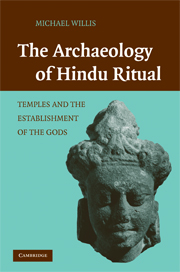 The cover of the book, depicting a Vaisnava head from Bhitrī, Uttar Pradesh, now in the British Museum, London. Jacket designed by Alice Soloway. | |
| Author | Michael D. Willis |
|---|---|
| Language | English |
| Subject | Hindu archaeology, Indian archaeology |
| Publisher | Cambridge University Press |
Publication date | 2009 |
| Publication place | United Kingdom |
| Media type | Print (Hardcover) |
| Pages | 375 |
| ISBN | 978-0521518741 |
The Archaeology of Hindu Ritual: Temples and the Establishment of the Gods is an archaeological study focusing on the early development of Hinduism within the Gupta Empire between the 4th and 6th centuries CE. It was written by the British archaeologist Michael D. Willis who was the curator of the South Asian and Himalayan collection at the British Museum at the time of the book being published by Cambridge University Press in 2009.
Considered to be the first major archaeological study to deal with the origins of Hinduism, The Archaeology of Hindu Ritual takes an interdisciplinary approach to the subject, making use of epigraphy, iconology and ethnography.[citation needed] The first chapter, "The Archaeology and Politics of Time at Udayagiri", pays particular attention to the ritual site at the Udayagiri Caves in Madhya Pradesh. The second, "Establishment of the Gods", looks at the development of temples and puja in India.
Willis' book was positively reviewed in various peer reviewed academic journals, such as South Asian Studies and the Religious Studies Review, as well as in popular Indian newspaper The Hindu. Critics described it as a groundbreaking study and praised its use of a variety of different forms of evidence, but some argued that it neglected to properly discuss the relationship between Hindu rituals and the religious practices of Buddhist and Jainist communities in Gupta India.
© MMXXIII Rich X Search. We shall prevail. All rights reserved. Rich X Search
